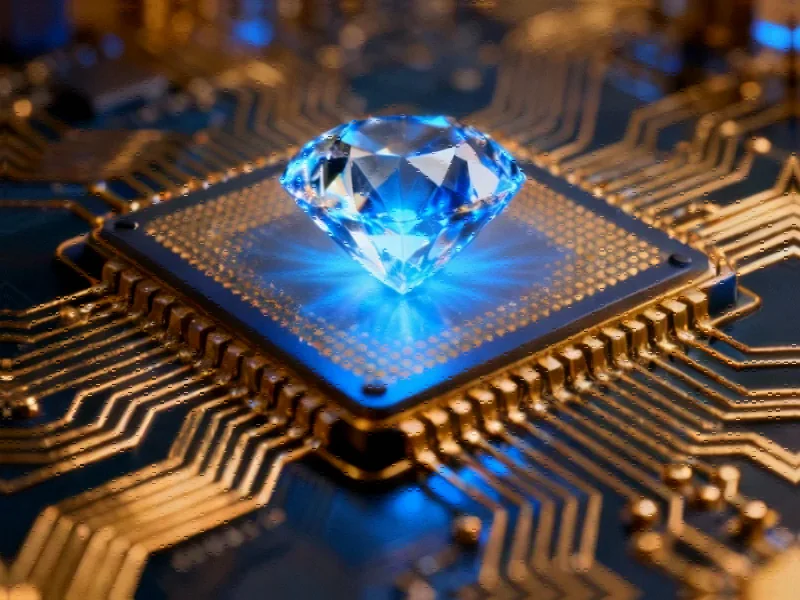The Overheating Crisis in Modern Electronics
As artificial intelligence systems and high-performance computing push processing capabilities to unprecedented levels, semiconductor manufacturers face an increasingly critical challenge: thermal management. The very transistors that enable our technological revolution generate immense heat when operating at gigahertz frequencies, creating hot spots that can exceed surrounding chip temperatures by tens of degrees. This thermal buildup forces performance throttling, reduces component lifespan, and ultimately limits computational potential across everything from smartphones to data centers.
The problem extends beyond traditional computing. In communication systems, power electronics, and emerging technologies, thermal constraints are becoming the primary bottleneck. As Nvidia’s latest GPU B300 servers demonstrate with their 15-kilowatt power consumption, the industry desperately needs innovative cooling solutions that can keep pace with escalating power densities.
Diamond’s Thermal Superpowers
While copper and aluminum have long served as thermal management workhorses, researchers are turning to an unexpected material with superior properties: diamond. With thermal conductivity reaching 2,200-2,400 watts per meter per kelvin—approximately six times that of copper—diamond represents a quantum leap in heat dissipation capability. What makes diamond particularly valuable for semiconductor applications is its combination of extreme thermal conductivity with electrical insulation, creating what researchers term a “thermal dielectric.”
Recent breakthroughs at Stanford University have overcome what was previously diamond’s greatest limitation for chip integration: the extreme temperatures required for deposition. Traditional diamond growth methods required temperatures exceeding 1,000°C—conditions that would destroy delicate semiconductor structures. The new low-temperature process developed at Stanford enables diamond deposition at just 400°C, compatible with existing CMOS manufacturing and advanced chip architectures.
Integration Breakthroughs and Industry Impact
The Stanford team’s approach involves growing polycrystalline diamond coatings directly on semiconductor devices at thicknesses of just a few micrometers. This represents a fundamental shift from previous attempts to use diamond as a semiconductor substrate itself. Early applications in gallium-nitride radio-frequency transistors demonstrated dramatic improvements, with device temperatures dropping by more than 50°C and signal amplification performance increasing fivefold.
These results have captured significant industry attention, with major players including Applied Materials, Samsung, and TSMC showing intense interest. The timing coincides with predictions that upcoming chip manufacturing technologies will create even hotter thermal hotspots, making diamond integration increasingly essential. This development represents one of many exciting industry developments in materials science that could reshape electronics manufacturing.
Overcoming Technical Hurdles
The path to practical diamond integration required solving multiple complex challenges. Researchers needed to develop diamond growth methods that produced large-grained crystals from the very beginning of the deposition process, ensuring effective lateral heat spreading. They also had to address the “phonon bottleneck” or thermal boundary resistance—the phenomenon where heat-carrying phonons encounter resistance at material interfaces.
Through extensive experimentation, the team discovered that adding oxygen to the deposition process helped etch away non-diamond carbon deposits, while a carefully optimized chemical formula enabled uniform diamond coatings around three-dimensional device structures. This advancement in thermal interface engineering represents a significant step forward, much like other related innovations in materials science that are pushing technological boundaries.
Broader Implications and Future Applications
The implications extend far beyond traditional computing. As electronics continue their relentless miniaturization and 3D chip stacking becomes more prevalent, thermal management becomes increasingly critical. Diamond’s unique properties could enable new architectures previously considered thermally impractical, including advanced diamond-coated chips that maintain performance under extreme conditions.
This thermal management breakthrough arrives alongside other significant technological advances, including recent technology in medical devices and important market trends in cybersecurity. Together, these developments highlight how materials science innovations often have cascading effects across multiple technology sectors.
The Road Ahead for Diamond Thermal Management
While significant challenges remain in scaling diamond deposition for mass production, the demonstrated benefits suggest a promising future. The ability to integrate diamond thermal spreaders within nanometers of heat-generating transistors represents a fundamental shift in thermal management strategy—moving from external cooling to integrated heat dissipation.
As research continues and manufacturing processes mature, diamond-enhanced thermal management could become standard in high-performance computing, telecommunications, power electronics, and consumer devices. This would mark a significant milestone in the ongoing evolution of semiconductor technology, potentially enabling the next generation of computational power that today remains thermally constrained.
The integration of diamond into semiconductor manufacturing represents not just an incremental improvement, but a potential paradigm shift in how we manage one of electronics’ most fundamental constraints: heat generation. As this technology develops alongside other materials science breakthroughs, we may be witnessing the dawn of a new era in computational capability.
This article aggregates information from publicly available sources. All trademarks and copyrights belong to their respective owners.
Note: Featured image is for illustrative purposes only and does not represent any specific product, service, or entity mentioned in this article.



